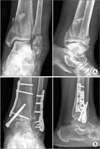Abstract
Purpose
Several studies have reported on the biomechanical advantages of a locking compression plate (LCP) for treatment of lateral malleolar fracture. However, few studies have reported clinical outcome after treatment of lateral malleolar fracture using a LCP in elderly patients. Thus, this study investigated the trends of lateral malleolar fractures in elderly patients and evaluated the clinical and radiological outcome of treating them using a 'locking compression distal fibula plate'.
Materials and Methods
Twenty-one patients (male: 3, female: 18) over 65 years old, who were followed-up for at least one year were enrolled in this study. They were treated surgically with open reduction and internal fixation using a LCP for lateral malleolar fracture from 2011 to 2014. Lauge-Hansen and Danis-Weber classification were used for preoperative classification of fractures. Visual analog scale (VAS) pain scores, the American Orthopaedic Foot and Ankle Society (AOFAS) ankle-hindfoot scores, 4-graded subjective satisfaction and post-operative range of motion were used for the clinical evaluation. Time to bone union, non-union, mal-union, metal failure and implant loosening were assessed for radiographic outcomes.
Results
The mean age of patients was 71.2 years old, pain VAS and AOFAS score was 1.6 points and 94.2 points, respectively and 18 cases (85.7%) showed more than satisfaction in subjective satisfaction. Comminuted fracture was observed in 8 cases (38.1%) and lag screw insertion was performed in 7 ankles (33.3%). The mean bony union period was 3.6 months. There were 5 cases of mal-union, no case of non-union and metal failure.
Conclusion
Satisfaction level of elderly patients with lateral malleolar fracture was significantly associated with only pain at the final follow-up. Fixation with a LCP distal fibula plate can sometimes lead to metal irritation but largely resulted in good clinical outcome without serious complication.
Figures and Tables
 | Figure 1A 71-year-old woman with a tri-malleolar ankle fracture. (A) Preoperative X-ray shows a severe comminuted fracture. (B) The patient was treated using a locking compression plate for distal fibula without interfragment lag screw fixation although malunion was observed at the final follow-up. |
 | Figure 2A 67-year-old woman shows a tri-malleolar ankle fracture. (A) Preoperative X-ray shows a lower level fracture line and transverse fracture line. (B) The patient was treated using a locking compression plate for distal fibula without interfragment screw fixation. |
References
1. Salai M, Dudkiewicz I, Novikov I, Amit Y, Chechick A. The epidemic of ankle fractures in the elderly: is surgical treatment warranted? Arch Orthop Trauma Surg. 2000; 120:511–513.
2. Strauss EJ, Egol KA. The management of ankle fractures in the elderly. Injury. 2007; 38:Suppl 3. S2–S9.

3. Srinivasan CM, Moran CG. Internal fixation of ankle fractures in the very elderly. Injury. 2001; 32:559–563.

4. Egol KA, Kubiak EN, Fulkerson E, Kummer FJ, Koval KJ. Biomechanics of locked plates and screws. J Orthop Trauma. 2004; 18:488–493.

5. Ring D. Current concepts in plate and screw fixation of osteoporotic proximal humerus fractures. Injury. 2007; 38:Suppl 3. S59–S68.

6. Schütz M, Müller M, Krettek C, et al. Minimally invasive fracture stabilization of distal femoral fractures with the LISS: a prospective multicenter study. Results of a clinical study with special emphasis on difficult cases. Injury. 2001; 32:Suppl 3. SC48–SC54.

7. Kim T, Ayturk UM, Haskell A, Miclau T, Puttlitz CM. Fixation of osteoporotic distal fibula fractures: a biomechanical comparison of locking versus conventional plates. J Foot Ankle Surg. 2007; 46:2–6.

8. Zahn RK, Frey S, Jakubietz RG, et al. A contoured locking plate for distal fibular fractures in osteoporotic bone: a biomechanical cadaver study. Injury. 2012; 43:718–725.

9. Chung HJ. Operative treatment with anatomically preshaped locking compression plate in distal fibular fracture. J Korean Foot Ankle Soc. 2013; 17:130–135.
10. Swart E, Bezhani H, Greisberg J, Vosseller JT. How long should patients be kept non-weight bearing after ankle fracture fixation? A survey of OTA and AOFAS members. Injury. 2015; 46:1127–1130.

11. Haller JM, Potter MQ, Kubiak EN. Weight bearing after a periarticular fracture: what is the evidence? Orthop Clin North Am. 2013; 44:509–519.
12. McLennan JG, Ungersma JA. A new approach to the treatment of ankle fractures. The Inyo nail. Clin Orthop Relat Res. 1986; 213:125–136.
13. Sohn JM, Jahng JH, Ha NK, Baek DH, Kim HG, Hyun BH. Pitfalls in treatment of lateral malleolar frcture with plate and screws. J Korean Soc Fract. 1998; 11:900–905.

14. Tsukada S, Otsuji M, Shiozaki A, et al. Locking versus nonlocking neutralization plates for treatment of lateral malleolar fractures: a randomized controlled trial. Int Orthop. 2013; 37:2451–2456.

15. Takemoto RC, Sugi MT, Kummer F, Koval KJ, Egol KA. The effects of locked and unlocked neutralization plates on load bearing of fractures fixed with a lag screw. J Orthop Trauma. 2012; 26:519–522.

16. McKenna PB, O'shea K, Burke T. Less is more: lag screw only fixation of lateral malleolar fractures. Int Orthop. 2007; 31:497–502.

17. Kim SK, Oh JK. One or two lag screws for fixation of Danis-Weber type B fractures of the ankle. J Trauma. 1999; 46:1039–1044.

18. Lee KH, Moon CW, Kim YS, Kim HM, Jung SL. Clinical comparison of ankle fractures between the young and the elderly. J Korean Foot Ankle Soc. 2005; 9:105–109.
19. Rajeev A, Senevirathna S, Radha S, Kashayap NS. Functional outcomes after fibula locking nail for fragility fractures of the ankle. J Foot Ankle Surg. 2011; 50:547–550.

20. Sakaki MH, Matsumura BA, Dotta Tde A, Pontin PA, Dos Santos AL, Fernandes TD. Epidemiologic study of ankle fractures in a tertiary hospital. Acta Ortop Bras. 2014; 22:90–93.

21. Lynde MJ, Sautter T, Hamilton GA, Schuberth JM. Complications after open reduction and internal fixation of ankle fractures in the elderly. Foot Ankle Surg. 2012; 18:103–107.

22. Schepers T, Van Lieshout EM, De Vries MR, Van der Elst M. Increased rates of wound complications with locking plates in distal fibular fractures. Injury. 2011; 42:1125–1129.





 PDF
PDF ePub
ePub Citation
Citation Print
Print






 XML Download
XML Download